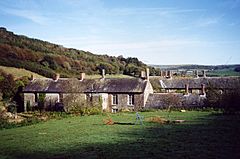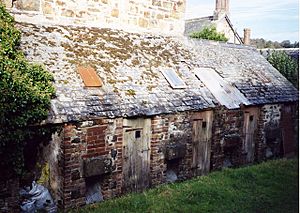Albro Castle facts for kids
Quick facts for kids Albro Castle |
|
|---|---|

Albro Castle in 2002
|
|
| Former names | Cardigan Union Workhouse |
| General information | |
| Town or city | St Dogmaels |
| Country | Wales |
| Coordinates | 52°05′20″N 4°41′13″W / 52.089°N 4.687°W |
| Completed | 1840 |
| Cost | £3,250 |
| Technical details | |
| Floor count | 2 |
| Design and construction | |
| Architect | William Owen |
| Main contractor | Benjamin Evans |
Albro Castle is a historic building in the village of St Dogmaels, Pembrokeshire, Wales. It was once a workhouse, a place where poor people could live and work in exchange for food and shelter. The building is considered very important because it's one of the best-preserved workhouses in Wales.
After it stopped being a workhouse in 1935, the local council bought the buildings. Later, in 1948, it was sold to private owners. Today, Albro Castle is used as holiday accommodation.
Contents
Building Albro Castle
The land for Albro Castle was bought for £290. A man named William Owen, from Haverfordwest, designed the building and oversaw its construction. Benjamin Evans was hired to build the workhouse for £2,700. Owen received £160 for his work.
The people in charge, called the Board of Guardians, decided to build fences around the workhouse. They also planned an access road from the nearby beach. In 1839, they made a rule that people who owned a dog could not get help from the workhouse.
The buildings were finished in 1840. The total cost was £3,250. The workhouse was meant to help poor people from 26 different parishes in Cardiganshire and Pembrokeshire.
Building Design
The original building had two floors. It included a special room for baking bread. The doorways and chimneys were built in a style popular during the Tudor period.
The whole complex had three main blocks. These blocks were connected by a central hallway. This design created four open courtyards. In the middle of the central hallway was a special observation room. It had angled windows, allowing staff to see into the courtyards. Inside, the main rooms were large and had windows on both sides, letting in lots of light. The stairs were made of stone.
History of Albro Castle
Life in the Workhouse
By the end of 1840, the Cardigan Union Workhouse was home to many people. This included 14 children born outside marriage and 13 children born within marriage. There were also 13 women who were able to work. In 1841, there were 43 residents, including a person who traveled a lot without a home.
Within two years, the workhouse was home to 102 people. Two years after that, the number grew to 224. Most of the residents were men. By 1845, there were 441 people living there. This was a lot, as the building was designed for only 120 residents.
In 1848, Ann Lundy, the daughter of the Master and Matron (the people in charge), became the schoolmistress. There were often problems at the workhouse. Both residents and staff caused disruptions. These events were often reported in local newspapers.
In the 1870s, about 130 people lived in the workhouse. The 1881 census showed 52 residents, including 3 staff members. In 1884, special cells were built for people who traveled without a home. These cells had grates and chutes for breaking stones.
In 1901, a group called the Ladies Visiting Committee noticed there was no infirmary. An infirmary is a place for sick people. They suggested setting up a room to separate those who were sick or dying from those who were just frail.
In the 1920s, the workhouse had unhealthy conditions. This led to cases of typhoid, a serious illness. In 1929, inspectors said it was the worst workhouse in Wales. The institution finally closed in 1935. Pembrokeshire County Council then took over the property.
World War II Barracks
During World War II, Albro Castle was used by the U.S. Army. From January 1944, it provided housing for the 111th Ordnance Company. This company had 180 soldiers and their vehicles, including trucks and tanks. On the night of June 6, 1944, known as D-day, they left for Normandy, France.
After the War
The property was sold in 1948. It was then changed into apartments and later into workshops. In 1992, it was given a Grade II* listing. This means it's a very important historic building. Today, Albro Castle is privately owned and used for holiday accommodation.


